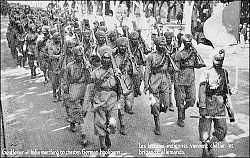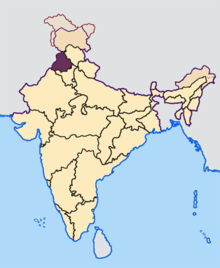Punjabi Tamba and Kurta

Punjabi Kurta and Tamba are traditional costume for men of Punjab.
Punjabi Tamba
The tamba, which is also called tehmat[1][2] is the Punjabi version of the lungi which has folds at the front and is the traditional dress for Punjabi men. The tamba is worn by Bhangra dancers. Although the use of the Punjabi tehmat has declined in recent years, being replaced by the pajamma, men can be seen wearing the tehmat in Punjab and its use has not completely stopped.[3]
When women wear the tehmat, it is referred to as a laacha. The laacha is worn in a like manner to the tehmat except it has more folds.
Punjabi Kurta



The term kurta is a generic term to cover different types of upper garments worn by men. The female version of the kurta is called the kurti. Kurta refers to the upper garments worn by Central Asian Turks who spread the use of the kurta to Persian speaking areas and beyond, reaching the Indian sub-continent.
The traditional male attire for men in India consisted of the dhoti and an unstitched cloth draped around the shoulders extended to cover the upper body. As time went on, men in North India began to use the Mughal jamma as the upper garment, which eventually led to different versions of the kurta being developed, such as the Punjabi kurta, the Gujarati angarkha and the Rajasthani angarkha, both also termed ‘kurta’. A non region specific angarkha is also worn in various areas such as in Himachal Pradesh, Uttrakhand and Uttar Pradesh. However, it is the Punjabi form of kurta which is popular throughout the sub-continent. It is for this reason that, in Bengal, Bangladesh and in Assam[4] the kurta is known as 'Panjabi' .
The male use of a stitched upper garment was initially extensively used in the Punjab and modelled on the Mughal kurta.[5] The Mughal kurta was much loose than the Punjabi kurta and had no side slits. Also, the upper part of the Mughal kurta was very loose. Over time, the Mughal kurta developed into the Punjabi kurta[6] which began to be worn by men with the [7] tehmat[8] (Punjabi dhoti) and pajamma.
Before the use of the kurta, people in Jammu traditionally wore the peshwaj[9] which flowed to the ankles. However, the traditional attire now is the kurta and Dogri pajjamma. The use of the kurta was very rare in Kashmir until Kashyap Bandhu encouraged its use in the 1930s cultural revolution.
Muktsari Kurta Pajamma
The Muktsari kurta pajamma is the modern Punjabi version of the traditional kurta pajamma outfit which is very popular on the sub-continent.[10]
Muktsari kurta pajammas were initially worn by youngsters in the Muktsar area. However, they are now popular all over Punjab. The Muktsari kurtas are snug with lapels on either side and the pyjamas are similar to well-fitted slim pants.[11] The kurta length is short and there's no pleating anywhere.[12]
References
- ↑ Development: A Saga of Two Worlds: Vismambhor Nath 2002 (Ashok Mukar Mittal Publishers)
- ↑ Lahore: A Sentimental Journey Pran Neville Penguin Books
- ↑ Alop Ho Reha Punjabi Virsa Harkesh Singh Kehal
- ↑ http://www.indianmirror.com/culture/clothing/dhoti.html
- ↑ Impact Of Hindu Culture On Muslims Mohsen Saeidi Madani
- ↑ Impact Of Hindu Culture On Muslims Mohsen Saeidi Madani
- ↑ Alop Ho Reha Punjabi Virsa Harkesh Singh Kehal
- ↑ Glossary of the Tribes and Castes of the Punjab and North East Volume 1 Ibbeston, Maclagan
- ↑ Textiles, Costumes and Ornaments of the Western Himalyas O Handa
- ↑ Puneet Pal Singh Gill Article The Tribune 04 01 2012
- ↑ Puneet Pal Singh Gill Article The Tribune 04 01 2012
- ↑ Puneet Pal Singh Gill Article The Tribune 04 01 2012
| ||||||||||
| ||||||||||||||||||
| |||||||||||||||||||||||||
